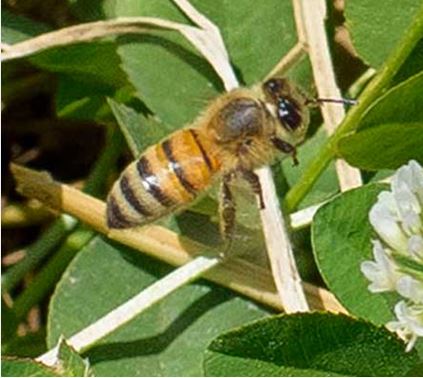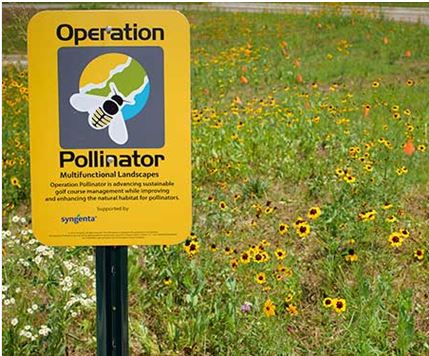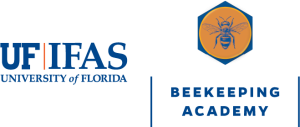By Nathan Gregory MISSISSIPPI STATE UNIVERSITY Ag Communications
STARKVILLE, Miss. — Backyard hobbyists and commercial producers of fruit and vegetable crops share a common need: pollinators.
Without them, flowering plants would be unable to produce fruit and seed. Bees are most commonly associated with pollination, but butterflies, hummingbirds and flies also are common pollinators.
A bee feeds on clover in the pollinator project garden at the Mississippi State University R.R. Foil Plant Science Research Center in Starkville June 16, 2015.
(Photo by Kevin Hudson/MSU Ag Communications)
A new pollinator project garden at the Mississippi State University R.R. Foil Plant Science Research Center in Starkville is funded in part by
Syngenta’s Operation Pollinator Habitat program.
(Photo by Kevin Hudson/MSU Ag Communications)
Enticing more animals to assist in transferring pollen often results in more fruits and vegetables from small, potted plants and large fields alike. Establishing pollinator-friendly habitat can be simple and doesn’t have to be expensive. Gardeners and producers can follow three general rules to get started.
- Provide diverse stands of plants
Jay McCurdy, turfgrass specialist with the Mississippi State University Extension Service, oversees a 5,000-square-foot pollinator project garden at the R.R. Foil Plant Science Research Center in Starkville. Currently, the garden contains 15 perennial, biennial and annual plant varieties, including coneflowers, sunflowers, sage, aster and black-eyed Susans.
McCurdy said the pollinator garden, which is in its first year of operation, is designed to attract numerous types of insect pollinators. He suggested gardeners consider a range of vegetation, particularly plants with strong root systems.
“Diversity in all things is key to pollinator success within human-disturbed areas,” McCurdy said. “We call this ‘reconciliation ecology.’ We’re trying to modify human habitats in order to make them better for wild species. That means planting multiple colors with both long and short durations of bloom, and varieties that bloom at different times of the year.”
Gary Bachman, Extension horticulturist at the MSU Coastal Research and Extension Center in Biloxi, said one of the more popular pollinator forages is milkweed.
“There are many milkweed species in Mississippi, including Asclepias tuberosa and swamp milkweed, A. incarnate,” Bachman said. “A nice milkweed that blooms all summer long is the tropical milkweed, Asclepias currassavica. Many garden centers carry this plant. While not winter hardy in Mississippi, tropical milkweed produces lots of foliage for caterpillars to forage upon. Any of the members of the milkweed family are good choices.”
Gardeners can select specific plant species, such as milkweed, that are beneficial to pollinators, but they can also set aside areas where natural vegetation can grow. Leslie Burger, Extension instructor in the MSU Forest and Wildlife Research Center, said providing field borders of native vegetation is helpful to producers and pollinators.
“Field borders and buffer strips reduce erosion and nutrient runoff, improve water quality, and take poor land out of production,” Burger said. “Field borders with native plants can also promote visits by pollinating insects and help increase yields. Reducing pesticide use will also help protect pollinating insects.”
- Build nests
Providing nesting habitats is a good way to entice return visits from bees, McCurdy said.
“Most evidence suggests that flowering plant material is only part of the solution,” he said. “There are around 4,000 species of bees in the U.S. Some nest in fallen timber while others nest in the ground. Others burrow into our houses and structures.”
Extension experts suggest that the best way to keep bees from making their own homes in houses is to build nesting areas for them. Dead trees or wooden blocks with drilled holes can serve as nesting sites for many native bees. For ground-nesting bees, avoid mowing some areas of a lawn or garden, or leave portions of a field untilled to provide grassy areas with undisturbed soil.
- Start small, but experiment
McCurdy said seeds for many pollinator-attracting plants are easily available. Most seeds need warm soil and full sunlight to successfully establish. An abundance of forage never hurts, but even small amounts increase the chance of attracting pollinators.
“If you want to start small, use existing plant material that you can gather right now. Milkweed is releasing seed now, and the wildflowers will soon set seed. These seed usually need a tilled site in order to become established,” McCurdy said. “Using a nonselective herbicide prior to planting is a good idea in order to decrease competition. The ‘grass-only’ herbicides, like sethoxydim or fluazifop, are also safe on broadleaf plants and help decrease bermudagrass and crabgrass encroachment.”
To read Extension publications on pollinator habitats for bees and wildflower selection, visit http://bit.ly/1Mg81Yi and http://bit.ly/1IMwxkE. Access more information from the Natural Resource Conservation Service at http://1.usa.gov/1Sa1BeY.








